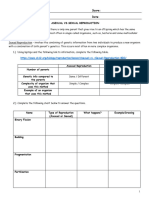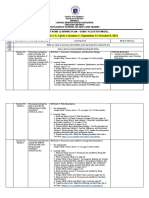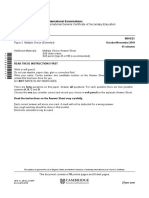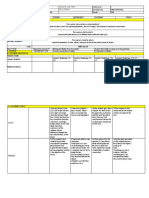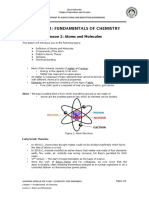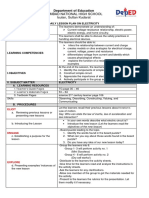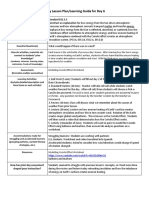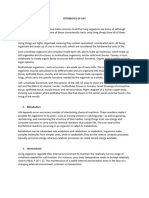0 ratings0% found this document useful (0 votes)
142 views7th Grade Science Curriculum Map Final Draft
7th Grade Science Curriculum Map Final Draft
Uploaded by
api-455790872The 7th grade science curriculum map outlines three units of study:
Unit 1 focuses on forces and their interaction with matter. Students will study Newton's laws of motion and create models of fields that exert forces without contact.
Unit 2 examines changes to Earth over time through geological processes. Students will construct explanations of how Earth's surface has changed at different scales and evaluate solutions to geologic hazards.
Unit 3 explores the structure and function of life at the cellular level. Students will develop models of cell anatomy and function, and construct explanations of how body systems are organized from cells to tissues to organs.
Copyright:
© All Rights Reserved
Available Formats
Download as DOCX, PDF, TXT or read online from Scribd
7th Grade Science Curriculum Map Final Draft
7th Grade Science Curriculum Map Final Draft
Uploaded by
api-4557908720 ratings0% found this document useful (0 votes)
142 views5 pagesThe 7th grade science curriculum map outlines three units of study:
Unit 1 focuses on forces and their interaction with matter. Students will study Newton's laws of motion and create models of fields that exert forces without contact.
Unit 2 examines changes to Earth over time through geological processes. Students will construct explanations of how Earth's surface has changed at different scales and evaluate solutions to geologic hazards.
Unit 3 explores the structure and function of life at the cellular level. Students will develop models of cell anatomy and function, and construct explanations of how body systems are organized from cells to tissues to organs.
Original Title
7th grade science curriculum map final draft
Copyright
© © All Rights Reserved
Available Formats
DOCX, PDF, TXT or read online from Scribd
Share this document
Did you find this document useful?
Is this content inappropriate?
The 7th grade science curriculum map outlines three units of study:
Unit 1 focuses on forces and their interaction with matter. Students will study Newton's laws of motion and create models of fields that exert forces without contact.
Unit 2 examines changes to Earth over time through geological processes. Students will construct explanations of how Earth's surface has changed at different scales and evaluate solutions to geologic hazards.
Unit 3 explores the structure and function of life at the cellular level. Students will develop models of cell anatomy and function, and construct explanations of how body systems are organized from cells to tissues to organs.
Copyright:
© All Rights Reserved
Available Formats
Download as DOCX, PDF, TXT or read online from Scribd
Download as docx, pdf, or txt
0 ratings0% found this document useful (0 votes)
142 views5 pages7th Grade Science Curriculum Map Final Draft
7th Grade Science Curriculum Map Final Draft
Uploaded by
api-455790872The 7th grade science curriculum map outlines three units of study:
Unit 1 focuses on forces and their interaction with matter. Students will study Newton's laws of motion and create models of fields that exert forces without contact.
Unit 2 examines changes to Earth over time through geological processes. Students will construct explanations of how Earth's surface has changed at different scales and evaluate solutions to geologic hazards.
Unit 3 explores the structure and function of life at the cellular level. Students will develop models of cell anatomy and function, and construct explanations of how body systems are organized from cells to tissues to organs.
Copyright:
© All Rights Reserved
Available Formats
Download as DOCX, PDF, TXT or read online from Scribd
Download as docx, pdf, or txt
You are on page 1of 5
7th Grade Science Curriculum Map
Unit 1: Forces Interact with Matter
Standards: 7.1.2 Apply Newton's Third Law to design a solution to a problem involving the motion of two colliding objects in a system. Examples
could include collisions between two moving objects or between a moving object and a stationary object.
7.1.3 Construct a model using observational evidence to describe the nature of fields that exist between objects that exert forces on each other
even though the objects are not in contact.
7.1.4 Collect and analyze data to determine the factors that affect the strength of electric and magnetic forces. Examples could include
electromagnets, electric motors, or generators.
Understandings: Cause and effect relationships rule everything. Essential Questions: Do patterns help us understand our world?
Assessments: Learning Activities:
1. Students will create a model that demonstrates the force 1. Review the scientific method and discuss how we use this method
between objects that are not touching (such as with magnets or in everyday life to observe and understand the world around us,
electricity) and explain the principle that is at work. Students will and how Newton used this method to come up with Newton’s
have a write-up with their model, outlining each step of the build Laws.
and an explanation of why it should work. Models will be 2. Magnets in the real world – students will watch a video on how
presented to a 3rd elementary class where the students will wrecking yard magnets work using electromagnetic forces.
explain how their model works to the younger students. Students will analyze and discuss the forces at work.
2. Students will imagine they are a NASA engineer tasked with 3. Forces in Action Stations – After building the models for each
designing a solution to keeping astronauts from being repelled station with the students, students will then move through stations
from the spacecraft when doing spacewalks. setup with a balloon activity, a magnetic maze activity, a catapult
activity, and a homopolar motor activity to learn about force, mass,
and velocity. Students will write a reflection after each station.
4. Students will watch a video about Astronaut Gene Cernan’s
spacewalk, record and share their observations, and generate
questions that will assist in designing their second assessment.
Resources: Cernans’s Spacewalk https://www.youtube.com/watch?v=W7d4Lxddij4&t=83s – a short video about the effects of Newton’s third
law that astronaut Gene Cernan experienced while doing a spacewalk in micro-gravity.
https://www.nasa.gov/feature/gemini-xii-crew-masters-the-challenges-of-spacewalks - this is an article that goes into a bit more detail about
how Newton’s third law was at play during Cernan’s spacewalk and why it was so challenging.
DIY electromagnet crane https://www.youtube.com/watch?v=3oisYFi7yYY - this video provides step-by-step instructions on how to create a
simple hydraulic crane with electromagnets using common items. This will provide students with a visual of how models are made.
Electromagnet Wrecking Yard https://www.youtube.com/watch?v=KumDUr33qmI&list=PLx1XtH5Enlm4WMTccB_SuanyEy1MNYPfT - Super
Charged Science Cast is a great resource that provides video lessons on science topics. This video explains how electromagnets work and how
we use them.
7th Grade Science Curriculum Map
Unit 2: Changes to Earth over Time (8 Weeks)
Standards: 7.2.2 Construct an explanation based on evidence for how processes have changed Earth’s surface at varying time and spatial scales.
Examples of processes that occur at varying time scales could include slow plate motions or rapid landslides. 7.2.3 Ask questions to identify
constraints of specific geologic hazards and evaluate competing design solutions for maintaining the stability of human-engineered structures
such as homes, roads and bridges. Examples of geologic hazards could include earthquakes, landslides, or floods.
Understandings: All relationships are dynamic. Essential Questions: Can lasting relationships be static?
Change is inevitable.
Assessments: Learning Activities:
1. Apocalypse America: Will Yellowstone Spell 1. Changes Over Time - Students will watch videos on the creation of landscapes such
Doom for the US? Students will research the as the Grand Canyon and the Himalayas then videos on the effects of landslides,
Yellowstone Caldera and write an article earthquakes, flooding. Students will then create a diagram of what is similar and
about it as if they were a journalist for what is different and discuss why.
National Geographic using what they have 2. Why Settle Here? Students will research an area, such as their hometown, and its
learned about plate tectonics and patterns of landscape to figure out why it was a good place to create a community when they
geological events. did. Was it good farmland? Did mining opportunities provide work for residents? Or
2. Students will research the recent fires that was the land unsettled for many years because it was not conducive to growing
have devastated the West and debate before food and relied on imports? How have natural disasters, such as fires and
a zoning committee and forest service earthquakes affected settlements?
members whether or not the loss of life and 3. Students will observe earthquakes and volcanic eruptions around the world,
property could have been prevented, including the Yellowstone Caldera, to come up with patterns to those events.
providing strong evidence for their claims. Students will then discuss whether or not humans are still limited by geography,
providing evidence for their claims.
4. Writing Workshop – Students will read short articles from various scientific
magazines and journals and we’ll discuss what makes a good article.
Resources: EarthViewer http://media.hhmi.org/biointeractive/earthviewer_web/earthviewer.html - This is a fantastic interactive website that
allows users to visualize the Earth, plate tectonic movement, mountain range formation, and climate changes throughout Earth’s past. Students
will be able to see where major geological events occurred throughout Earth history and see a pattern to those events.
Back to School Burn https://www.jpl.nasa.gov/edu/news/2016/8/22/back-to-school-burn-the-science-of-wildfires/ - this is an article provided
by NASA that explains why we have a fire season in the West and why it’s been so bad lately. It also includes some lessons on how scientists
study fires using GIS as well as an interactive view from space of wildfires.
Grand Canyon Formation https://www.youtube.com/watch?v=t6IBg4Srb6E video from the Smithsonian on the formation of the Grand Canyon.
Explains how traditional thinking of landscape formations was challenged by observations from the Grand Canyon.
Himalaya/Appalachian Formation https://www.youtube.com/watch?v=mR8n1vkF9lU – video on how continental drift formed these mountain
chains and continues to grow the Himalayan Plateau.
7th Grade Science Curriculum Map
Unit 3: Structure and Function of Life (7 Weeks)
Standards: 7.3.2 Develop and use a model to describe the function of a cell in living systems and the way parts of cells contribute to cell
function. Emphasize the cell as a system, including the interrelating roles of the nucleus, chloroplasts, mitochondria, cell membrane, and cell
wall.
7.3.3 Construct an explanation using evidence to explain how body systems have various levels of organization. Emphasize understanding that
cells form tissues, tissues form organs, and organs form systems specialized for particular body functions.
Standards:
Understandings: To understand the whole, you must Essential Questions: Are structure, function, and balance essential to healthy
understand its smaller components. life?
Assessments: Learning Activities:
1. Students will imagine they are a cellular biologist working at 1. Students will look at various cells, such as cheek cells, onion cells, and
the University of Utah doing research on cell function and ripe vs. green banana cells under a microscope and identify as many
present a method to stimulate cellular regeneration for features as possible. Will review proper handling of microscopes.
severe injuries. 2. Class will discuss real world analogies of the function of cell parts,
such as the nucleus being the principal’s office, the DNA is the school
files, the teachers are the ribosomes, the students are proteins, and
the school bus is a vesicle.
3. Students will create a visual model of a eukaryotic animal cell with
structures and their functions defined.
4. Cell model – What’s Missing? I will remove organelles from the cell
and students will tell me what is missing and how that would affect
cell function.
5. Cellular regeneration video – watch video and discuss how cells differ
in other animals and what we can learn about cell regeneration in
humans by studying these animals.
Resources: Animal Cell Regeneration https://www.youtube.com/watch?v=QFa6jP6WgzM – video that explains how some animals are able to
regrow limbs.
Human cell regeneration https://www.youtube.com/watch?v=CYScX-cIWC0 – video explains how there are some tissues in the human body
that are capable of regeneration after a traumatic injury.
Regeneration and Stem Cells https://www.eurostemcell.org/regeneration-what-does-it-mean-and-how-does-it-work - EU article about how
regeneration operates and how stem cells can be used to repair damaged tissues and organs.
7th Grade Science Curriculum Map
Unit 4: Reproduction and Inheritance (7 Weeks)
Standards: 7.4.1 Develop and use a model to explain the effect that different types of reproduction have on genetic variation, including asexual
and sexual reproduction.
7.4.2 Obtain, evaluate, and communicate information about specific animal and plant adaptations and structures that affect the probability of
successful reproduction.
7.4.4 Obtain, evaluate, and communicate information about the technologies that have changed the way humans affect the inheritance of
desired traits in organisms.
Understandings: Biology creates us and shapes us, but it doesn’t Essential Questions: What makes us “us”?
define us. To what extent is DNA destiny?
Assessments: Learning Activities:
1. Students will research genome editing and prepare a 1. Natural Selection Stations – Students will rotate through stations that
presentation as though they were at a medical conference simulate natural selection. Stations will include camouflage pompom
on preventing and treating hereditary diseases. activity, spoon and jellybean activity, and a cricket game to find a mate.
2. Designer Babies. It is currently illegal to edit human Students learn how different adaptations contribute to differences in
embryos. Imagine if it became legal. Students will create an survival and reproductive success, which results in changing frequencies
advertisement for/against genome editing with strong claims of genotypes in the populations.
for their position. If for, try to convince people that may 2. Students will choose one organism that reproduces sexually and one that
believe it is wrong because of unforeseen ramifications. If reproduces asexually and create a comparison diagram. Students will
against, try to convince people that think there are no ethical then choose which organism they believe is more successful in passing
problems with genome editing. along its DNA and why.
3. Nature vs. Nurture – students will hear about studies of twins separated
at birth and the amazing coincidences they share. Students will then
discuss how much they believe nature vs. nurture determines our future.
4. RadioLab CRSPR – students will listen to a podcast about CRSPR, a gene
editing company, take notes and participate in a fishbowl discussion
about the podcast.
Resources: CRSPR Radiolab podcast https://www.wnycstudios.org/story/update-crispr - Jad and Robert delve into the amazing world of genetic
manipulation, learning about ways that it can one day be used to treat cancer, but also discussing the ethical ramifications of altering lifeforms,
including human embryos.
Twins Separated at Birth https://www.livescience.com/47288-twin-study-importance-of-genetics.html - a Live Science article on a study the
University of Minnesota conducted for 20 years on the role genetics plays in our lives by looking at twins that were separated at birth.
7th Grade Science Curriculum Map
Unit 5: Changes in Species over Time (7 Weeks)
Standards: 7.5.1
Construct an explanation that describes how the genetic variation of traits in a population can affect some individuals' probability of surviving
and reproducing in a specific environment.
Understandings: Adaptations are essential to survival. Essential Questions: What happens when change occurs faster than
adaptation?
Assessments: Learning Activities:
1. Students will pick a native species (plant or animal) and 1. Field Trip to Hogle Zoo – Utah is home to several unique species that can
hypothesize how that species could adapt to changes in its be found at the Hogle Zoo. Class will visit and learn more about these
environment. They will include changes to its physiology and species and how they adapted to Utah’s climate and terrain and the
behavior. They will bring a model of their organism in a challenges these species now face.
medium of their choosing. 2. Nowhere To Hide – students will watch an online movie and participate
2. Students will research evidence of climate change and its in an interactive activity that teaches about adaptations and natural
impact on Utah weather patterns and debate whether or not selection using the peppered moth as an example.
that evidence supports human-caused claims. 3. Students will watch a documentary on changing Arctic ice and how it is
affecting animals that rely on it. We’ll then discuss how polar bears are
adapting and whether or not these changes in individual bear’s
behaviors are enough to spare the species.
Resources: States at Risk http://statesatrisk.org/utah - this site provides the major risks each state faces as global temperatures continue to rise.
For Utah, the major risks are extreme heat, drought, and wildfires. Students can delve deeper into each risk category and learn how that will
affect wildlife, vegetation, disease, and other factors.
Nowhere to Hide http://sciencenetlinks.com/lessons/nowhere-to-hide/ - Science Net Links provides multiple lessons and ideas for creating
content that is more accessible to learners. The concept of natural selection appears to be difficult for many to grasp, so Science Net Link
created the Nowhere to Hide lesson and activity to help students better understand the functions behind natural selection.,
A Warmer World for Arctic Animals https://www.youtube.com/watch?v=2aRHN10ognM – PBS documentary on the effects climate change has
on Arctic animals, such as competition from southern animals, loss of critical sea ice, and loss of habitat.
Can Wildlife Adapt to Climate Change? https://www.youtube.com/watch?v=ZCKRjP_DMII – Ted Ed video created by Erin Eastwood that
explains that adaptations take time and while some animals may exhibit adaptive evolutionary changes, these changes are typically plastic and
not inheritable. Scientists are studying species that have exhibited adaptive evolution to study what makes them unique in adapting to a rapidly
changing environment.
You might also like
- Making A Poster Rubric 1Document1 pageMaking A Poster Rubric 1mary joy quintosNo ratings yet
- Build An Atom Worksheet-AnswersDocument3 pagesBuild An Atom Worksheet-AnswersBilly JoeNo ratings yet
- Grade 8 Science: Manitoba Education and Training 2000Document50 pagesGrade 8 Science: Manitoba Education and Training 2000Henry LanguisanNo ratings yet
- Meiosis Lab Foldable ActivityDocument2 pagesMeiosis Lab Foldable Activityanon_3743148350% (1)
- Biological Science Term 2 Learning Sequence 2013Document5 pagesBiological Science Term 2 Learning Sequence 2013api-226538617No ratings yet
- LESSON 02 - Verbs We Commonly Use in The Passive Phrasal Verbs Verb Preposition. Language Defined SapirDocument4 pagesLESSON 02 - Verbs We Commonly Use in The Passive Phrasal Verbs Verb Preposition. Language Defined SapirMadalina TicuNo ratings yet
- Animal Behavior Chapter 1Document14 pagesAnimal Behavior Chapter 1StudentNo ratings yet
- Worksheet - Sexual and Asexual Reproduction - NO-AnswersDocument2 pagesWorksheet - Sexual and Asexual Reproduction - NO-AnswersJeric Valad-onNo ratings yet
- Quezon City High School Science, Technology and Engineering (Ste) ProgramDocument2 pagesQuezon City High School Science, Technology and Engineering (Ste) ProgramJonathanEncomiendaNo ratings yet
- Understanding by Design: Lesson PlanDocument3 pagesUnderstanding by Design: Lesson Planapi-420907551No ratings yet
- Pedigree Lesson PlanDocument3 pagesPedigree Lesson Planapi-517763318100% (1)
- Sample Lesson Plan - GeneticsDocument31 pagesSample Lesson Plan - Geneticsapi-388740335No ratings yet
- DNA ReplicationDocument7 pagesDNA ReplicationjimmyNo ratings yet
- Hand Out For OpticsDocument19 pagesHand Out For OpticsnidharshanNo ratings yet
- Lesson Plan: Grade Level 8 Quarter/Domain 1 Quarter Week & Day No. Week 7 Page NoDocument2 pagesLesson Plan: Grade Level 8 Quarter/Domain 1 Quarter Week & Day No. Week 7 Page NoJuvi Mae Burgos ObenzaNo ratings yet
- Notes - Introduction To Genetics MendelDocument6 pagesNotes - Introduction To Genetics Mendelapi-271661638No ratings yet
- Dna Replication Lesson PlanDocument14 pagesDna Replication Lesson PlanKatsunori TolentinoNo ratings yet
- GRADE 10, Week 1-4, Cycle 1, Quarter 1, September 13-October 8, 2021Document4 pagesGRADE 10, Week 1-4, Cycle 1, Quarter 1, September 13-October 8, 2021orlan sison100% (1)
- Science 10 Ddl11Document3 pagesScience 10 Ddl11JOCELYN CAMACHONo ratings yet
- Kinetic and Potential Energy WebquestDocument5 pagesKinetic and Potential Energy Webquestapi-262586446No ratings yet
- Nucleosynthesis - Formation of Elements Heavier Than IronDocument4 pagesNucleosynthesis - Formation of Elements Heavier Than IronDaniah AllemaNo ratings yet
- Static Electricity 5e Lesson PlanDocument13 pagesStatic Electricity 5e Lesson Planapi-411072238No ratings yet
- Atom Model Proj RubricDocument3 pagesAtom Model Proj Rubricapi-273794219No ratings yet
- Science 9 2nd Summative TestDocument3 pagesScience 9 2nd Summative TestEmerlyn JosephNo ratings yet
- Lesson 4 Motion in 2 and 3DDocument27 pagesLesson 4 Motion in 2 and 3DPhea Blairre JingcoNo ratings yet
- HEREDITY AND VARIATION Grade 10Document111 pagesHEREDITY AND VARIATION Grade 10MARVIN COMAYASNo ratings yet
- Physics Reviewer Notes: Compiled by Nikko Angelo CarismaDocument7 pagesPhysics Reviewer Notes: Compiled by Nikko Angelo CarismaThe Black Swordsman PHNo ratings yet
- Holt MCD Earth Science Chapter 6 PDFDocument32 pagesHolt MCD Earth Science Chapter 6 PDFAbegail GabineNo ratings yet
- Course Outline Sciences Year 3Document4 pagesCourse Outline Sciences Year 3zarna nirmal rawalNo ratings yet
- Reflection and Refraction SimulationDocument5 pagesReflection and Refraction SimulationEduFeatNo ratings yet
- Science 8 Course Outline 2016-2017Document2 pagesScience 8 Course Outline 2016-2017api-329970569No ratings yet
- Stem PDFDocument16 pagesStem PDFPhoemela Joyce Roa LustreNo ratings yet
- Contact and Noncontact Forces StationDocument12 pagesContact and Noncontact Forces StationDemanda GookinNo ratings yet
- Evidence of Evolution: Part 1. Homologous StructuresDocument5 pagesEvidence of Evolution: Part 1. Homologous StructuresrexNo ratings yet
- Lesson Plan Full Lead 4 11 Spongebob-Squarepants Genetics 2f Reteach For Punnett SquaresDocument3 pagesLesson Plan Full Lead 4 11 Spongebob-Squarepants Genetics 2f Reteach For Punnett Squaresapi-403223123No ratings yet
- Looking Through The LensesDocument2 pagesLooking Through The LensesLen LenNo ratings yet
- 0610 w18 QP 21-CIE-IGCSE-BiologyDocument20 pages0610 w18 QP 21-CIE-IGCSE-BiologyRahulBansuman100% (1)
- Inherited Traits and Learning BehavioursDocument3 pagesInherited Traits and Learning BehavioursSabha HamadNo ratings yet
- Week 1 Hormones in Male and Female Reproductive SystemDocument9 pagesWeek 1 Hormones in Male and Female Reproductive SystemJohnpaul MalicsiNo ratings yet
- Naming CompoundsDocument17 pagesNaming CompoundsTrisha Mae ArellanoNo ratings yet
- Grade 9 Chemistry Quiz 2Document8 pagesGrade 9 Chemistry Quiz 2nhatduong170522No ratings yet
- Grade 8 GuideDocument39 pagesGrade 8 GuideBreeza Marie VeralloNo ratings yet
- Butterfly Life Cycle Lesson PlanDocument4 pagesButterfly Life Cycle Lesson PlanPeter GeorgeNo ratings yet
- Balanced and Unbalanced Forces Lesson Plan GGDocument3 pagesBalanced and Unbalanced Forces Lesson Plan GGSaima Usman - 41700/TCHR/MGBNo ratings yet
- Chapter 1: Fundamentals of Chemistry: Lesson 2: Atoms and MoleculesDocument9 pagesChapter 1: Fundamentals of Chemistry: Lesson 2: Atoms and MoleculesKristine Cris VenusNo ratings yet
- Human Body Systems ProjectDocument7 pagesHuman Body Systems ProjectSiraj ShaikNo ratings yet
- Protein Synthesis WorksheetDocument4 pagesProtein Synthesis Worksheetmichelle.baguioNo ratings yet
- Lesson Plan Final PoDocument11 pagesLesson Plan Final PoFelyn DelaCruz - DalinoNo ratings yet
- Pulley Lab InquiryDocument4 pagesPulley Lab InquiryjameeloNo ratings yet
- Bambad National High School Isulan, Sultan Kudarat: Department of EducationDocument2 pagesBambad National High School Isulan, Sultan Kudarat: Department of EducationKebu YenNo ratings yet
- Meiosis LabDocument2 pagesMeiosis Labapi-197683383No ratings yet
- Balanced and Unbalanced Forces Independent WorkDocument6 pagesBalanced and Unbalanced Forces Independent Workapi-3725481460% (1)
- Work Energy Worksheet PacketDocument14 pagesWork Energy Worksheet PacketSara Afzal0% (1)
- Naming Covalent CompoundsDocument6 pagesNaming Covalent Compoundsapi-296446442100% (1)
- HeatDocument23 pagesHeatNinja ni BUHAY BUKID MIX VLOGNo ratings yet
- PHYS Module 2 WorksheetsDocument16 pagesPHYS Module 2 WorksheetsPrathmesh Sinha100% (1)
- Dead Astronomer SocietyDocument1 pageDead Astronomer SocietySandra MillerNo ratings yet
- Science 8 MatrixDocument24 pagesScience 8 MatrixBing Sepe CulajaoNo ratings yet
- Unit Plan - Kinematics - Sph3uDocument17 pagesUnit Plan - Kinematics - Sph3uapi-350400617No ratings yet
- Department of Education: Republic of The PhilippinesDocument5 pagesDepartment of Education: Republic of The Philippinesmaricar relatorNo ratings yet
- (Owls) Reading Essentials c.21-2 How Body Systems InteractDocument8 pages(Owls) Reading Essentials c.21-2 How Body Systems InteractJasna CárdenasNo ratings yet
- Physics: Grade 7Document28 pagesPhysics: Grade 7Jun Carrie GaoNo ratings yet
- STEMJOBS LessonPlan InterstellarDocument4 pagesSTEMJOBS LessonPlan InterstellarSergio Villalobos FlórezNo ratings yet
- Daily Lesson Plan/Learning Guide For Day 1Document2 pagesDaily Lesson Plan/Learning Guide For Day 1api-455790872No ratings yet
- Daily ReflectionsDocument4 pagesDaily Reflectionsapi-455790872No ratings yet
- Lesson Plan Day 6Document1 pageLesson Plan Day 6api-455790872No ratings yet
- Weather UnitDocument2 pagesWeather Unitapi-455790872No ratings yet
- Assessment RubricDocument1 pageAssessment Rubricapi-455790872No ratings yet
- Assessment PromptDocument2 pagesAssessment Promptapi-455790872No ratings yet
- Uths Bio1 BDocument12 pagesUths Bio1 BKennZ FrenzyNo ratings yet
- Alee - Ecological Animal Geography (1951)Document749 pagesAlee - Ecological Animal Geography (1951)caegeospNo ratings yet
- Bios Megafauna RulesDocument24 pagesBios Megafauna RulesstetsonNo ratings yet
- Natural SelectionDocument31 pagesNatural SelectionAnonymous MvL5rvS100% (1)
- Organization As Flux and TransformationDocument3 pagesOrganization As Flux and Transformationhajra khan0% (1)
- Theory of Evolution by Natural Selection Part 2Document3 pagesTheory of Evolution by Natural Selection Part 2tileshadowNo ratings yet
- Edexcel GCE Biology AS Unit 2 NotesDocument11 pagesEdexcel GCE Biology AS Unit 2 Notescolachau0% (1)
- Science AdaptationsDocument3 pagesScience Adaptationsapi-182002518No ratings yet
- Dawkins and DarwinDocument4 pagesDawkins and DarwinIyaElagoNo ratings yet
- AnthropologyDocument209 pagesAnthropologyStiff Yilma67% (3)
- Evolution Term Paper TopicsDocument4 pagesEvolution Term Paper Topicsea8dfysf100% (1)
- 70 Bio Essay QSNS 0706 851 439Document19 pages70 Bio Essay QSNS 0706 851 439gicherutony4No ratings yet
- Camouflage Lesson PlanDocument4 pagesCamouflage Lesson Planapi-344569443No ratings yet
- Animal Adaptations Activity BookDocument8 pagesAnimal Adaptations Activity Bookapi-450175685No ratings yet
- Does Evolutionary Theory Need A RethinkDocument4 pagesDoes Evolutionary Theory Need A RethinkecologiafcaunlNo ratings yet
- CAMBRIDGE-LESSON PLAN - General Science - Grade VIII - TC Yeva - Unit 2 Living Things in Their EnvirontmentDocument5 pagesCAMBRIDGE-LESSON PLAN - General Science - Grade VIII - TC Yeva - Unit 2 Living Things in Their EnvirontmentYeva OlensiaNo ratings yet
- Sister Caliista RoyDocument10 pagesSister Caliista RoyJade R. GoNo ratings yet
- Ocean Animal AdaptationsDocument4 pagesOcean Animal Adaptationsapi-253003084No ratings yet
- Ch. 23 Lecture Outline PDFDocument15 pagesCh. 23 Lecture Outline PDFCSERM UNASNo ratings yet
- Aquatic Adaptations - Poonam SinghDocument46 pagesAquatic Adaptations - Poonam Singhaksahu01234No ratings yet
- SCI10 Q3 M8 Adaptation and Ecological StabilityDocument18 pagesSCI10 Q3 M8 Adaptation and Ecological StabilityDoreen Lorraine ZabaleNo ratings yet
- The Basics of Evolution - Anne WanjieDocument135 pagesThe Basics of Evolution - Anne Wanjienadine marchandNo ratings yet
- Recovery and Regeneration For Long-Term Athlete DevelopmentDocument11 pagesRecovery and Regeneration For Long-Term Athlete DevelopmentSpeed Skating Canada - Patinage de vitesse CanadaNo ratings yet
- Attributes of LifeDocument3 pagesAttributes of LifeZoeNo ratings yet
- Unifying Themes in The Study of LifeDocument7 pagesUnifying Themes in The Study of LifeKyla Renz de Leon100% (6)
- Student Name: - Class: - Date: - Instructions: Read Each Question Carefully and Circle The Correct AnswerDocument11 pagesStudent Name: - Class: - Date: - Instructions: Read Each Question Carefully and Circle The Correct AnswerJason PantojaNo ratings yet
- Gee11b PrelimsDocument1 pageGee11b PrelimsGdeity PlaysNo ratings yet







